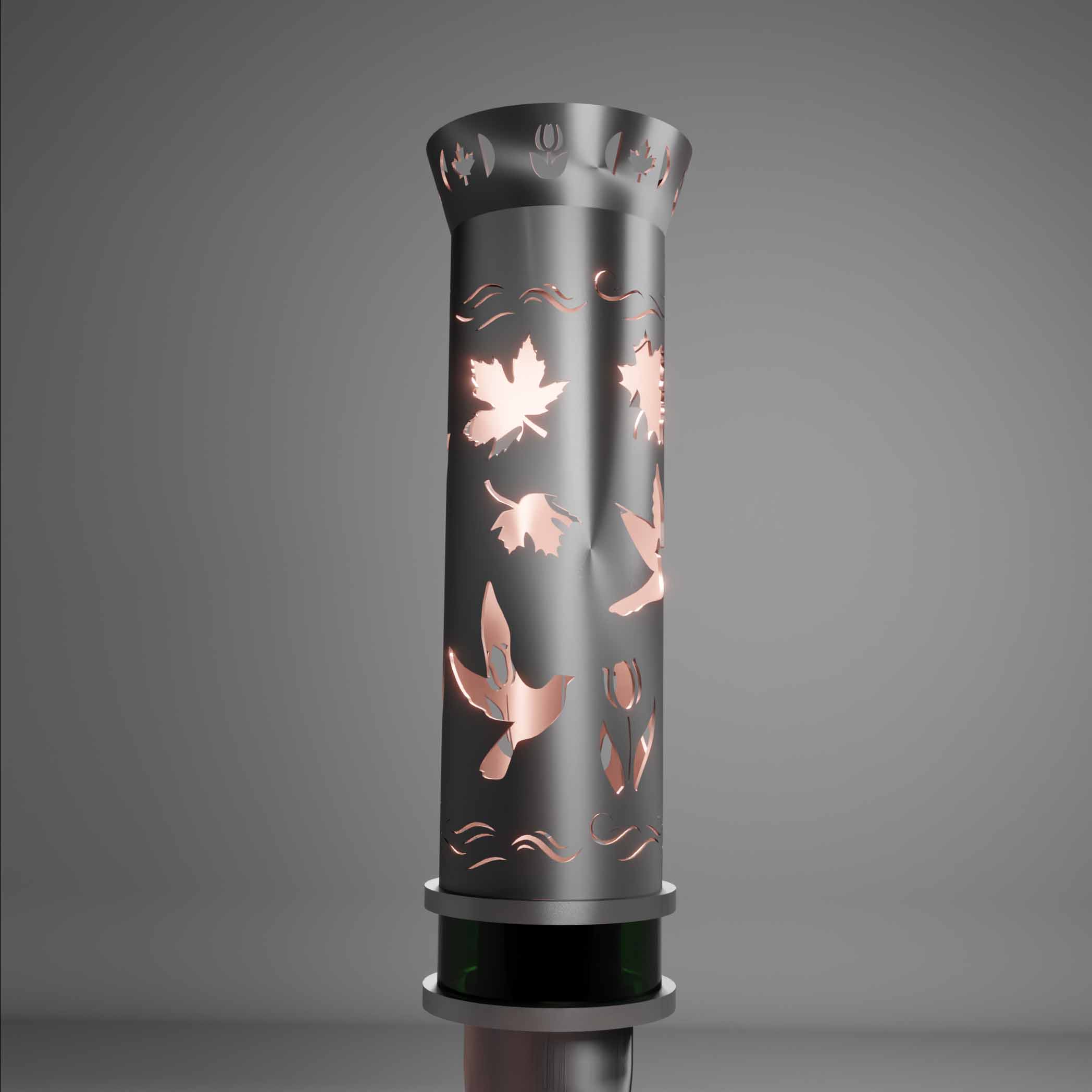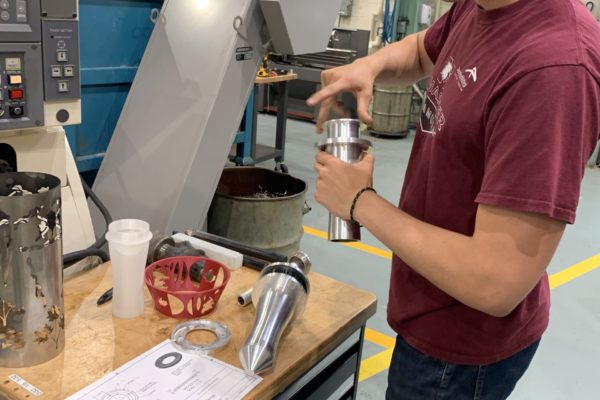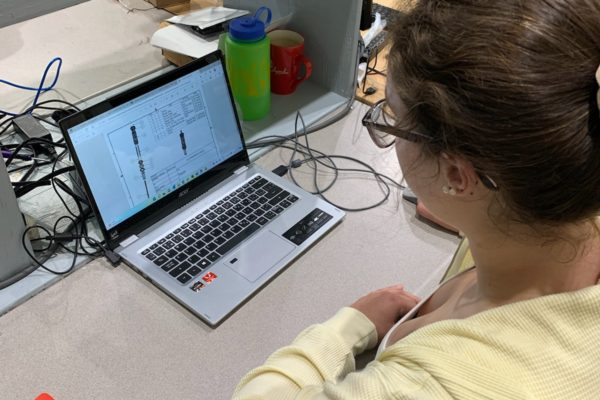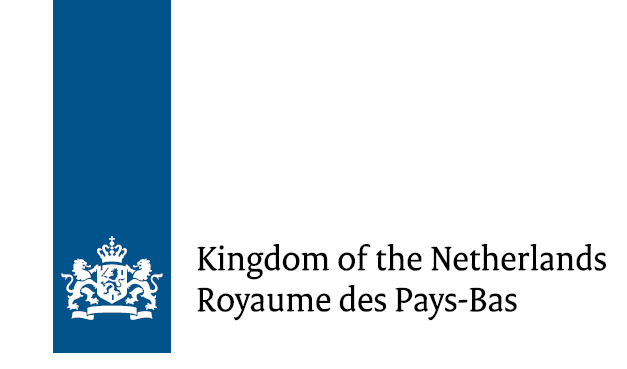
Four teams of McMaster Engineering students spent several months designing the first Canadian Remembrance Torch that would accompany the 2022 “In Our Fathers’ Footsteps” pilgrimage to the Netherlands. The teams’ innovative designs were presented and judged at a virtual Showcase attended by a special guest, Don White, a Second World War veteran who served in the Netherlands.
Team Avro Lancaster’s winning design was built at the University. The Design team accompanied the Torch on its journey overseas.
The Canadian Remembrance Torch: 2022
“In Our Fathers’ Footsteps”
Design Elements:
Doves symbolize peace and friendship, specifically the bond between Canada and the Netherlands, and the peace brought about by their collaboration. Many cultures and religions often use birds, particularly doves, to depict the souls of people who have passed. Therefore, the upward flying doves also symbolize the ascension of those who lost their lives during the Dutch occupation and liberation.
Maple Leaves and Tulips represent Canada and the Netherlands. The tulips also symbolize the thousands of bulbs gifted to Canada each year in thanks for the Liberation and Canada’s role in keeping the Dutch Royal Family safe during the war.
Waves represent some of the most significant battles and strategic movements during the Dutch Liberation, which all took place on or around water. These include the Battle of the Scheldt, Operation Market-Garden, Operation Veritable, Operation Cannonshot, and the Battle for the Kapelsche Veer.
LED lights inside the Torch (when illuminated) pulse with the torchbearer’s heartbeat. Each person’s unique signature represents human energy as the source of the remembrance flame’s continuity.
“We will remember” (on interchangeable coloured glass) represents unity, appearing in three languages (English, French, and Dutch) and three symbols for Canada’s Indigenous groups: First Nations, Innuit, and Métis.
Meet The Team

I come from Dutch and Italian parentage and was born in Delft in the Netherlands. I moved to Calgary when I was seven, and I still have very strong ties to my home country. In fact, most of my maternal extended family resides in the Netherlands. Both my maternal and paternal grandparents lived through occupation in the Second World War, my paternal grandparents being liberated by the Americans in Italy, and my maternal grandparents by the Canadians, of course! I believe my great grandfather was an officer in the Dutch army as well. Given my unique background with ties to both the Netherlands and Canada, this project has been particularly meaningful to me. It’s very special to be able to pay tribute to two nations that are such an integral part of my identity, and the shared history that has had a profound impact on my story.
How has your involvement in The Canadian Remembrance Torch project influenced you?
I’ve learned a couple key lessons so far in this journey. From an engineering standpoint, this is the first time I’ll have worked through a design project to create a finished product. Through working with peers, staff, and faculty members at the university, I’ve developed skills to take a conceptual engineering design and make it feasible for the real world. Some of the new things I’ve had to think about are manufacturing processes, fastening and assembly methods, material availability, weight, and cost. In addition, I have been able to practice taking an engineering design and simplifying it to a fraction of the initial complexity, while increasing functionality. From a SWW-related standpoint, I was reminded from conversations with my grandparents of the immensity of SWW’s impact. After the Netherlands was liberated, things didn’t just immediately get better; there were massive rifts within society and an entire nation was left reeling with trauma trying to figure out how to get back on its feet. To think that our nations were able to work together to repair and rebuild themselves is truly remarkable. From a personal standpoint, I learnt much about the strength of the bonds and love within my family to overcome hardship. Regardless of the strains and complexities in the family dynamics, every member had without fail taken massive risks and made sacrifices to ensure each other’s survival and well-being. It makes me so incredibly proud to be part of that legacy.
What do you hope to gain by participating in “In Our Fathers’ Footsteps?
I hope that by participating in IOFF, I can continue to learn about my own background and the backgrounds of two countries that have shaped me. I hope to acknowledge the generations that have come before me – their pain, their sacrifices, their growth, and their joys. Finally, I hope to share through my engineering work what our mutual history and the bond between our nations looks like through my eyes, and that the beauty I see resonates with people.

I am Indian and was born in New York but grew up in Brampton. I don’t have any relatives who served in the Second World War, but I do have family members who live in the Netherlands and Europe and who are well versed in the history of it.
How has your involvement in The Canadian Remembrance Torch project influenced you?
I’ve learned the deep relationship that Canada and the Netherlands have for each other and the different contributions and sacrifices that we’ve made to establish freedom in Europe. As well as the different ways that both Canadians and the Dutch people have celebrated and honoured the SWW. When designing and working on the torch, we’ve researched incorporating as many aspects of Canadian and Dutch symbols, important events, and representing other important, yet overlooked, historical aspects such as the Indigenous contribution to the SWW. These perspectives added onto the overall scope of the project and made me think of broader ways to answer design challenges.
What do you hope to gain by participating in “In Our Fathers’ Footsteps”?
In participating in IOFF I hope that I can gain insight into the history behind the SWW and understand the way it has strongly impacted us today.

I was born in Canada, but my grandparents were not. My paternal grandparents are from England. My grandfather joined the Royal Navy in 1944-46 in preparation for the Pacific scene but never saw action as the war ended. My grandmother was very young at the time but remembers living under rations and constant threat of air raids. My maternal grandfather lived in Italy and was a young boy during the war. He was very poor and took up work at the POW camp down the road from his hometown near Sulmona, Abbruzzo, Italy. He remembers the Canadian POWs that were captured in the liberation of Italy. One day, he was cleaning around the camp and the Canadians picked him up, and carried him through the full length of the barracks as if he was one of their own sons back home. My young grandfather was so distressed after, the POWs gave him some chocolate and rations to bring home to his family. Later in the war, when Italy declared war on the Axis powers, the POW camp was left open and unguarded. The POWs took to the hills but my grandfather went back into the camp and found guns and munitions left behind. Being a teenager, he took as many guns as he could carry but as he was leaving, an SS troop stopped him at gunpoint. He was only saved by the grace of a neighbour who pleaded with the soldier. Years later, my grandfather would join the Alpinista core of the Italian military.
I have always been interested in war history as long as I can remember. I read books about Canadian bomber pilots and studied the aircraft. I wanted to become a pilot when I was younger, but in the end these interests drove me toward Mechanical Engineering. I studied history electives and joined the History club in High School to learn more about the Second World War.
How has your involvement in The Canadian Remembrance Torch project influenced you?
I’ve learned an incredible amount about the Liberation of the Netherlands and the events surrounding those operations. I learned about the combative and non-combative missions conducted by Canadians to help the Dutch people, including a mission involving glider aircraft and strategic air support to slow the German retreat. I read about my favourite Canadian author, Farley Mowat, who was a soldier in the CAF during these operations. I’ve learned so much about the meaning behind many symbols of remembrance in Canada and the Netherlands. I’ve also gained technical insight through the design of this torch, which is a challenging task for many reasons. I’ve learned about different manufacturing techniques that can help us produce a functional and beautiful final product. I continue to learn more every day that I’m on this project. I’m excited to keep pushing on this project!
What do you hope to gain by participating in “In Our Fathers’ Footsteps”?
As part of IOFF, I hope to continue to learn about the history of the SWW through a Canadian lens, while taking in the culture of the Netherlands. In Canada, we are so far removed from the reality of the SWW because no battles were ever fought here but being able to walk the path of the Canadian forces will really bring that to life for me. I hope to gain lifelong memories on this incredible journey and bring back to Canada what I’ve learned there.
Judging Categories
Creativity
Feasibility & Functionality
Effort &
Inspiration
Aesthetics
Team: Avro Lancaster
Yuvraj Sandhu,
Computer Engineering and Management
Shafai Nadeem,
Electrical Engineering
“The Torch contest gave us a rare opportunity to be as creative as possible and tap into our inner designer.”
Team: Liberators
Sebastian Tattersall,
Mechanical Engineering, 3rd year
Nicole Cheung,
Mechanical Engineering, 3rd year
Lucille Zhong:
Engineering, 1st year
“This milestone project challenged us to design imaginatively, push ourselves technically, and learn about a piece of history that must never be forgotten.”
Team: Entrenched
Riley Dowd,
Mechatronics Engineering, 2nd year
William Song,
Mechanical Engineering, 2nd year
Zakrea Shirzad,
Mechanical Engineering, 2nd year













































